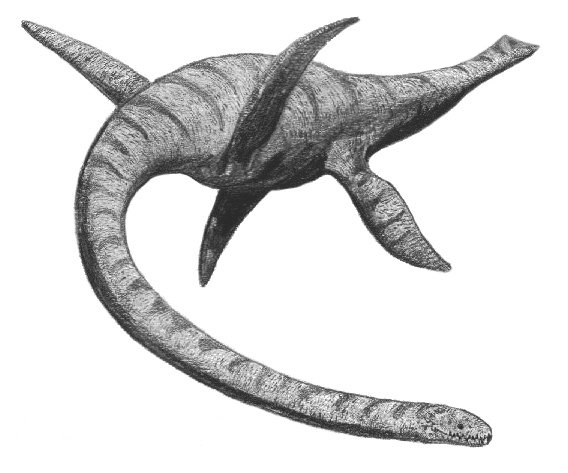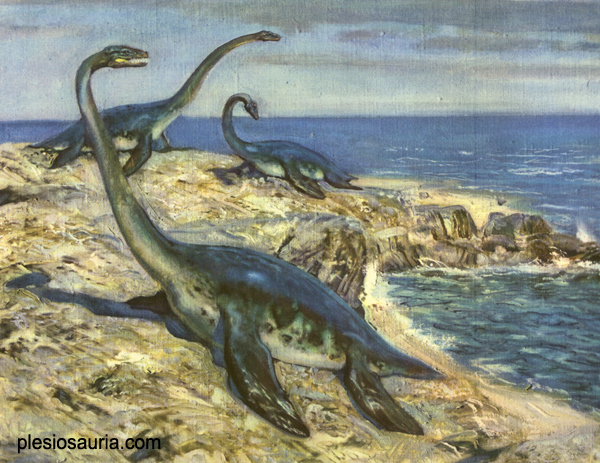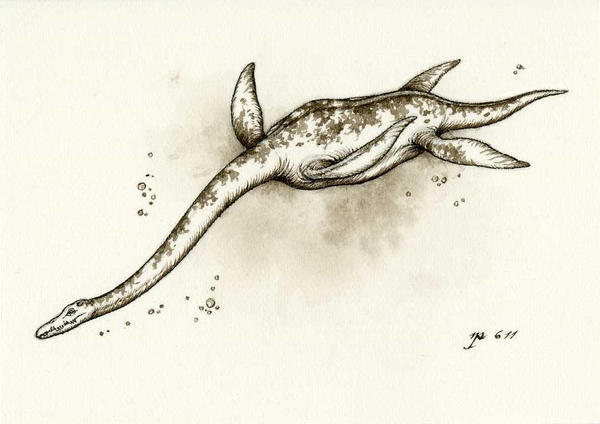[Recent Entries][Archive][Friends][User Info]
Below are the 3 most recent journal entries recorded in the "Сообщество, посвящённое ра" journal:| April 26th, 2012 | |
|---|---|
| 07:55 pm [industrialterro] [Link] |
Plesiosaurus Plesiosaurus (Greek: πλησιος/plesios, near to + σαυρος/sauros, lizard) was a genus of large marine sauropterygian reptile that lived during the early part of the Jurassic Period, and is known by nearly complete skeletons from the Lias of England. It was distinguished by its small head, long and slender neck, broad turtle-like body, a short tail, and two pairs of large, elongated paddles. It lends its name to the order Plesiosauria, of which it is an early, but fairly typical member. It contains only one species, Plesiosaurus dolichodeirus. P. brachypterygius, P. guilielmiiperatoris and P. tournemirensis were assigned to new genera, Hydrorion, Seeleyosaurus and Occitanosaurus. Compared to other plesiosaur genera, Plesiosaurus has a small head. The skull is much narrower than long, reaching its greatest width just behind the eyes (the postorbital bar). The anterior portion is "bluntly triangular". In lateral view, the skull reaches its highest point at the rear of the skull table. "The external nostrils overlie the internal nares". They are not positioned at the tip of the snout, but farther back, nearer the eyes than the tip of the skull. Unlike the nostrils of Rhomaleosaurus, they do not appear to be adapted for underwater olfaction. The orbits (eye sockets) are roughly circular and are positioned about halfway along the length of the skull. They face up and to the sides. Just posterior to the orbits are the supratemporal fenestrae, which are about the same size as the orbits and also roughly circular. Between the four openings is the pineal foramen, and between the temporal fenestrae is a narrow sagittal ridge. As in other plesiosaurs, the pterygoids of the palate are fused to the basioccipital of the braincase, although the union is not as robust as in the pliosaurs Rhomaleosaurus and Pliosaurus. "The palatal bones are thin, but there is no suborbital fenestra." The two rami of the lower jaw make a "V" shape with an angle of about 45°. The specialized region where they meet, the symphysis, is robust. The two rami are fused at the symphysis, making a pointed, shallow scoop-like shape. The teeth of Plesiosaurus are "simple, needle-like cones" that are "slightly curved and circular in transverse section". They are sharply pointed with fine striations running from tip to base, and point forward (procumbent). This procumbency becomes more pronounced near the leading end of the skull, where they may be only 10-15° above horizontal. There are 20 to 25 teeth per upper jaw tooth row, and 24 per low jaw tooth row. Up to four teeth of a lower jaw's tooth row are found in the symphyseal region. Plesiosaurus was a moderately-sized plesiosaur that grew to a length of about 3.5 metres (11 ft). There are approximately 40 cervical vertebrae (neck vertebrae), with different specimens preserving 38 to 42 cervical vertebrae. Of the rest of the vertebral column, there are a handful (four or five in the holotype specimen) of "pectoral" vertebrae from the neck-torso transition, approximately 21 dorsal or back vertebrae, three or more sacral vertebrae, and at least 28 caudal vertebrae. Generally, the centra of the cervical vertebrae are relatively elongated, being slightly longer than tall. The width, however, is usually greater than or equal to the length. The articular surfaces of the cervical centra are "slightly concave and kidney-shaped, with rounded, slightly rugose edges." Small holes called foramina subcentralia are found on the ventral surface of the centra. Some of the dorsals have rugose articular edges, like the cervicals; this feature is typically absent from the caudals. Ribs are found from the neck to the tail. Cervical ribs are hatchet-shaped and have two articular heads. Dorsal ribs are thick and have only one head. Sacral ribs are "short, robust, and blunt or knob-like on both ends." Caudal ribs have different morphologies depending on their location along the tail, with anterior examples being pointed and more distal examples being "broad and blunt." Plesiosaurus also has gastralia, also known as "belly ribs." Nine or more sets of gastralia are present between the shoulder and pelvis. Each set is composed of seven elements: a bone on the midline flanked by three lateral elements. The shoulder girdle is only partly known but appears to be typical for plesiosaurs. It includes fused clavicles at the anterior end, scapulae (shoulder blades), and large coracoids. The scapulae and coracoids both contribute to the glenoids (arm sockets). A pair of oval holes called pectoral fenestrae are found midway along the scapular/coracoid contacts. The forelimbs are elongate and relatively narrow compared to those of most plesiosaurs. The humerus (upper arm bone) has distinctive curvature, which appears to be a retained primitive feature among sauropterygians. Mature Plesiosaurus also have a distinctive groove along the ventral surface of the humerus. The forearm includes a flat, broad, crescent-shaped ulna and a "robust and pillar-like" radius. The wrist includes six bones. The hand paddle has five digits; the phalangeal formula is uncertain, but the count for one large individual, from "thumb" to fifth "finger", is 4-8-9-8-6. The pelvis includes equant pubic bones, ischia, and blade-shaped ilia connecting the pelvis to the vertebral column. The acetabulum is formed by surfaces on the pubic bones and ischia. Similar to the pectoral girdle, there is a pair of holes between the ischia and pubic bones. The hindlimbs are long and narrow, and in adults, they are much smaller than the forelimbs. The thigh bones are straight. The lower hindlimb includes two roughly equal-sized bones, the robust tibia and the semilunate-shaped fibula. There are six bones in the ankle. The foot paddle includes five digits. Like the hand, the phalangeal formula is uncertain, but is at least 3-7-9-8-7 from innermost to outer "toe". Unequivocal specimens of Plesiosaurus dolichodeirus are limited to the Lyme Regis area of Dorset. It appears to be the most common species of plesiosaur in the Lias Group of England. Plesiosaurus is best represented from the "upper part of the Blue Lias, the 'Shales with Beef,' and the lower Black Ven Marls"; using the Lias Group ammonite fossil zones, these rocks date to the early Sinemurian stage. Some other Pleisosaurus fossils are from later Sinemurian rocks. The oldest specimen may be a skull thought to come from late Rhaetian or early Hettangian rocks. Plesiosaurus fed on belemnites, fish and other prey. Its U-shaped jaw and sharp teeth would have been like a fish trap. It propelled itself by the paddles, the tail being too short to be of much use. Its neck could have been used as a rudder when navigating during a chase. It is unknown if Plesiosaurus laid eggs on land like sea turtles or gave live birth in the water like sea snakes. The young might have lived in estuaries before going in the open ocean.
Репродукции (1, 2, 3, 4, 5, 6, 7, 8, 9):
( Далее ) Размеры тела в сравнении с человеком:
Ископаемые останки (1, 2, 3, 4, 5):
Tags: Вымершие рептилии, Юра, диапсиды, завроптеригии, лепидозавроморфы, плезиозавриды, плезиозавроиды, плезиозавры |
| April 25th, 2012 | |
| 06:54 pm [industrialterro] [Link] |
Hydrorion Hydrorion (meaning 'water hunter') is an extinct genus of plesiosaur. It was found in Jurassic formations in Germany. The only species is Hydrorion brachypterygius.
Tags: Вымершие рептилии, Юра, диапсиды, завроптеригии, лепидозавроморфы, плезиозавриды, плезиозавроиды, плезиозавры |
| April 21st, 2012 | |
| 05:02 pm [industrialterro] [Link] |
Attenborosaurus Attenborosaurus is an extinct genus of plesiosaur from the Early Jurassic of Dorset, England. The type species is A. conybeari. The genus is named after David Attenborough, the species after William Conybeare. Плезиозавры (Plesiosauria, греч. πλησιος — близкий, схожий, σαυρος — ящер) — отряд ископаемых пресмыкающихся, живших с триасового по меловой периоды (около 199,6 — 65,5 млн лет назад). Расцвет пришёлся на юру — ранний мел. Плезиозавры были прекрасно приспособлены к жизни в водоемах, хотя им приходилось выныривать на поверхность, чтобы вдохнуть воздуха. Имели четыре конечности, преобразованные в ласты, и бочкообразное тело. У одних были длинные шеи и маленькие головы, у других — короткие шеи и огромные головы. Обитали в солоноводных водоёмах — морях и океанах. Останки обнаружены на всех континентах, в том числе и в Антарктиде. В начале девятнадцатого века понятия плезиозавры еще не было. В то время также не было таких систематических таксонов как рыбы, млекопитающие и рептилии, не было никакой систематической разделенности внутри Ichthyosauria. В 1821 году Уильям Конибер и Генри Томас де ла Беш нашли некоторые отличия у исследуемых ими видов животных от ихтиозавра. Они назвали новую форму плезиозавром. В 1824 году в Англии, в окрестностях городка Лайм-Реджис, в скальной породе на берегу моря любитель-палеонтолог Мэри Эннинг откопала полный скелет раннеюрского плезиозавра вида Plesiosaurus dolishodeirus. Это была первая задокументированная находка плезиозавра. Мэри продала этот скелет. Скелет попал в руки палеонтолога Уильяма Коньирома, который в тот же год описал ящера. Затем Мэри обнаружила ещё два скелета. В 1868 году палеонтолог Эдвард Дринкер Коп описал из Верхнемеловых отложений Канзаса (США) плезиозавра Elasmosaurus platyurus. При реконструкции он совершил ошибку, поместив голову эласмозавра на кончик хвоста, а не на конец шеи. В дальнейшем соперник Копа, Гофнил Чарльз Марш, указал на эту ошибку. С тех пор останки плезиозавров обнаружены на всех материках, особенно останки многочисленны в юрских отложениях Европы; в СНГ останки плезиозавров встречаются в Среднем Поволжье, Заволжье, северо-западной части Казахстана и Якутии. Плезиозавры в основном питались моллюсками и рыбой. Крупные виды питались другими морскими рептилиями и летающими ящерами. Один из обнаруженных палеонтологами плезиозавров сохранил в области желудка остатки своей последней трапезы — труп летающего ящера, кости рыбы и раковину аммонита. Споры о способах размножения плезиозавров длятся вот уже 200 лет. Многие эксперты полагали, что из-за большого веса выбираться на берег и откладывать яйца животному было затруднительно, то есть они должны были быть живородящими. Первое прямое доказательство этой гипотезы было получено после тщательного изучения окаменелого скелета плезиозавра (он около 20 лет находился в подвале Музея естественной истории в Лос-Анджелесе).
Tags: Вымершие рептилии, Юра, диапсиды, завроптеригии, лепидозавроморфы, плезиозавриды, плезиозавроиды, плезиозавры |




















